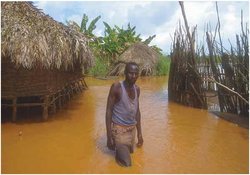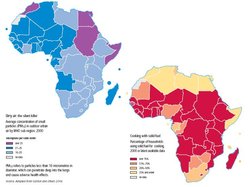Threats to atmospheric resources in Africa
Contents
Climate variability and change
Climate change is a major threat to atmospheric resources and is resulting in climatic variations that have effects at multiple scales – temporal and spatial. It is closely linked to global patterns of energy consumption and production. Its impacts are increased by poor natural resource management.
Climate change has multiple impacts, at diverse scales and in particular affects ecosystems, which in turn affect livelihoods and human well-being. Even a temperature rise of as little as 1°C will affect land, coastal and marine (Marine ecosystem services), freshwater, and forests and woodland resources. Biodiversity will also be affected, as will human settlements. New health challenges are expected as vector-borne diseases, such as malaria, are predicted to increase. Environmental change affects food production systems, contributing to malnutrition, famine and starvation, and insect ranges and numbers, increasing the incidence of diseases such as malaria. Climate change contributes to population displacement, undermining social cohesion and cultures.
Several factors, including an over-dependence on rain-fed agriculture and the high incidence of poverty, make Africa’s people particularly vulnerable to climate variability. Poor people have little protection against extreme climatic events: they have few resource reserves, poor building structures, and depend directly on natural resources for their livelihoods. Extreme weather events have serious economic and business implications. Floods and droughts cause damage to property and loss of life that affect the opportunities available and that increase the cost of business through higher insurance premiums and claims.

(Source: G. Griffiths/CHRISTIAN AID/Still Pictures)
Climatic variations manifest themselves as extreme weather variations, such as floods and droughts. These events are increasing in magnitude and frequency over the years. The mean annual rainfall has been decreasing over the decades. Many countries, including Botswana, Burkina Faso, Chad, Ethiopia, Kenya, Mauritania and Mozambique, experience drought at regular intervals. The 1997-98 El Niño floods caused heavy damage to roads, buildings, bridges, railway lines and other property including schools. Incidences of epidemic diseases such as malaria increased during this period. This is related to improved conditions for mosquito breeding; mosquitoes transmit many viruses, over 100 of which are known to infect humans, including malaria, dengue, yellow fever and severe and sometimes fatal encephalitis and dengue haemorrhagic fever. Cholera, which is transmitted by water or food, could aggravate health problems in many parts of the world including Africa. During the 1997-98 El Niño event, excessive flooding is reported to have caused epidemics in Djibouti, Somalia, Kenya, Tanzania and Mozambique.
Mean global [[temperature]s] are rising, slowly but surely. This rise in global temperature is attributed to anthropogenic emission of greenhouse gases (GHGs), particularly carbon dioxide. Greenhouse gas emissions result from the burning of fossil fuels in industry, transport vehicles, waste disposal and in households. Africa contributed 341,836 m3 of CO2 in 1970, or 2.2 percent of global emissions; by 2000 this had risen to nearly 3.6 percent of global emissions. Although African emission levels are low, their steady increase demands increased investment in clean production processes and the fulfillment of the commitment made by industrialized countries at the World Summit on Sustainable Development (WSSD) to support Africa in this through partnership and investment.
Climate change is causing the rapid melting of snow caps and a concomitant rise in sea level. For example, the glaciers on Mount Kilimanjaro have shrunk by 73 percent over the century. This process may result in the displacement of people, loss of lowland areas, reduced agricultural production, health problems and enhanced climate variability.
Atmospheric pollution
In comparison to developed countries, Africa’s air pollution (Air pollution emissions) levels are still relatively low. However, air pollution is increasing fairly fast as a result of increasing population, urbanization and industrial production. Major pollutants include sulfur dioxide, carbon monoxide, soot, dust and lead. For large industrial cities, like Cairo, Egypt, air pollution is of immediate concern. Indoor air pollution emanating from the burning of fuelwood is another area of concern.
Many factors contribute to increasing air degradation. Inefficient industrial technologies and vehicle emissions are important contributors in urban areas. High dependency on old vehicles is a result of the high taxes many governments place on new vehicles and the lack of financial resources available to consumers. The lack of emission controls on vehicles, and poor monitoring and enforcement systems, exacerbate pollution problems. The transportation system, with its use of trucks for long-distance transportation of goods and poor railway systems, contributes to pollution problems. Open burning of waste also contributes to air degradation. In rural areas, burning of biomass for energy services in small-scale industries like brick firing contributes to air pollution. The use of biomass fuel for cooking and heating in households also lowers the quality of air. Indoor air pollution disproportionately affects women and children as women bear the burden of cooking and are thus more vulnerable. Improving air quality is essential for improving health, and in particular for reducing the maternal and child mortality rates as envisaged in the Millennium Development Goals (MDGs).
Ozone layer depletion
The ozone layer shields people and plants from harm from ultraviolet radiation, which causes skin cancer and cataracts in people, stunts growth in plants, including food crops, and kills the tiny organisms which form the base of the marine food chain.
The ozone layer is threatened by the production of industrial chemical emissions, particularly the chlorofluorocarbons (CFCs). These chemicals are stable and stay long enough in the atmosphere to reach the ozone layer where they decompose due to strong radiation and eventually react with and destroy the ozone layer, causing "holes" that let the ultraviolet (UV) radiation through. The rapidly rising level of UV-radiation in some parts of the world is alarming: in the Arctic, their intensities are 130 percent higher than 1970s levels.
Measures to reduce the release of CFCs into the atmosphere have now been stipulated in the Montreal Protocol. Parties to the Montreal Protocol agreed to phase out CFCs, halons and carbon tetrachloride by 2000, and methyl chloroforms by 2005. A global fund to help developing countries adopt environmentally friendly technology was established. Most African countries have taken the opportunity to eliminate ozone-depleting substances (ODS) through national action plans.
Further Reading
- Akhtar, R. et al., 2001. Chapter 9: Human Health. In Climate Change 2001: Impacts, Adaptation, and Vulnerability (Threats to atmospheric resources in Africa) (eds. McCarthy, J. J., et al.), pp. 451-85. Intergovernmental Panel on Climate Change. Cambridge University Press, Cambridge.
- Christy, J. R. et al., 2001. Chapter 2: Observed Climate Variability and Change. In Climate Change 2001: Impacts, Adaptation, and Vulnerability (Threats to atmospheric resources in Africa) (eds. McCarthy, J. J. et al.), pp. 99-181. Intergovernmental Panel on Climate Change. Cambridge University Press, Cambridge.
- Gordon, B., Mackay, R. and Rehfuess, E., 2004. Inheriting the World: the Atlas of Children’s Environmental Health and the Environment. World Health Organization, Geneva.
- Hassan, R., Scholes, R. and Ash, N. (eds. 2005). Ecosystems and Human Wellbeing: Current State and Trends, Volume 1. Findings of the Condition and Trends Working Group of the Millennium Ecosystem Assessment. Island press, Washington, D.C.
- Mastny, L., 2000. Melting of Earth’s Ice Cover Reaches New High. Worldwatch News Brief, 6 March.
- UNEP, 2006. Africa Environment Outlook 2
- UNSTAT/CDIAC, 2006. Millennium Indicators Database. United Nations Statistics Division/Carbon Dioxide Information Analysis Center.
|
|
| Disclaimer: This article is taken wholly from, or contains information that was originally published by, the United Nations Environment Programme. Topic editors and authors for the Encyclopedia of Earth may have edited its content or added new information. The use of information from the United Nations Environment Programme should not be construed as support for or endorsement by that organization for any new information added by EoE personnel, or for any editing of the original content. |
